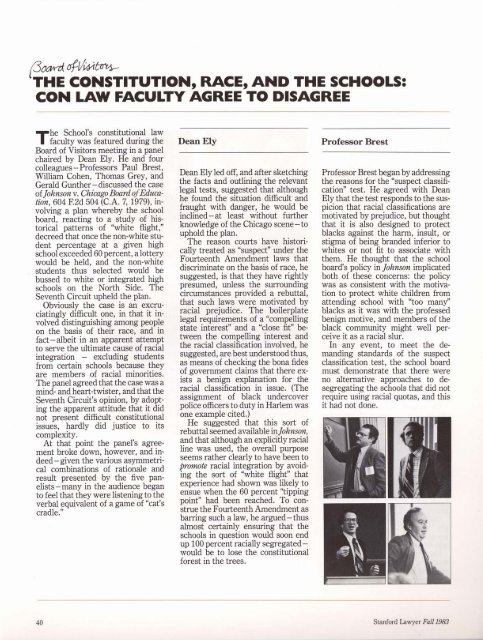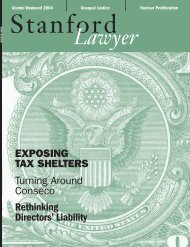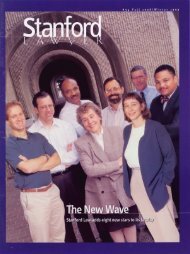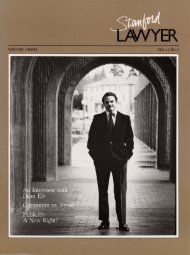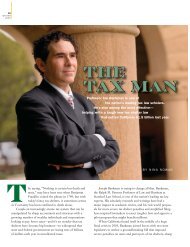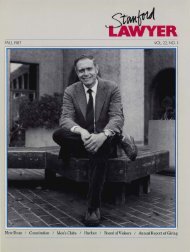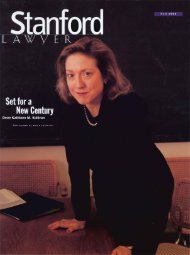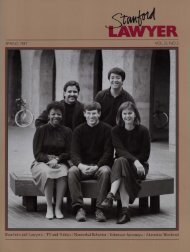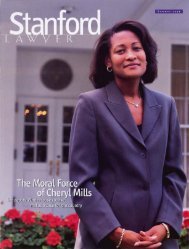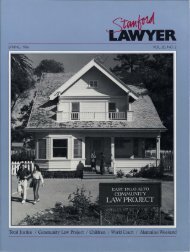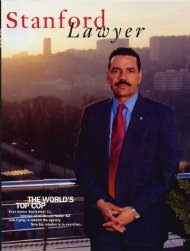@.oarcA 4l!141~THE CONSTITUTION, RACE, AND THE SCHOOLS:CON LAW FACULTY AGREE TO DISAGREEThe School's constitutional lawfacwty was featured during theBoard of Visitors meeting in a panelchaired by Dean Ely. He and fourcolleagues - Professors Paul Brest,William Cohen, Thomas Grey, andGerald Gunther- discussed the caseofJohnson v. Chicago Board ofEducation,604 R2d 504 (C.A. 7, 1979), involvinga plan whereby the schoolboard, reacting to a study of historicalpatterns of "white flight,"decreed that once the non-white studentpercentage at a given highschool exceeded 60 percent, a lotterywould be held, and the non-whitestudents thus selected would bebussed to white or integrated highschools on the North Side. TheSeventh Circuit upheld the plan.Obviously the case is an excruciatinglydifficwt one, in that it involveddistinguishing among peopleon the basis of their race, and infact-albeit in an apparent attemptto serve the wtimate cause of racialintegration - excluding studentsfrom certain schools because theyare members of racial minorities.The panel agreed that the case was amind- and heart-twister, and that theSeventh Circuit's opinion, byadoptingthe apparent attitude that it didnot present difficwt constitutionalissues, hardly did justice to itscomplexity.At that point the panel's agreementbroke down, however, and indeed- given the various asymmetricalcombinations of rationale andresult presented by the five panelists- many in the audience beganto feel that they were listening to theverbal equivalent of a game of "cat'scradle."Dean ElyDean Ely led off, and after sketchingthe facts and outlining the relevantlegal tests, suggested that althoughhe found the situation difficwt andfraught with danger, he would beinclined - at least without furtherknowledge of the Chicago scene - touphold the plan.The reason courts have historicallytreated as "suspect" under theFourteenth Amendment laws thatdiscriminate on the basis of race, hesuggested, is that they have rightlypresumed, unless the surroundingcircumstances provided a rebuttal,that such laws were motivated byracial prejudice. The boilerplatelegal requirements of a "compellingstate interest" and a "close fit" betweenthe compelling interest andthe racial classification involved, hesuggested, are best understood thus,as means of checking the bona fidesof government claims that there existsa benign explanation for theracial classification in issue. (Theassignment of black undercoverpolice officers to duty in Harlem wasone example cited.)He suggested that this sort ofrebuttal seemed available inJohnson,and that although an explicitly racialline was used, the overall purposeseems rather clearly to have been topromote racial integration by avoidingthe sort of "white flight" thatexperience had shown was likely toensue when the 60 percent "tippingpoint" had been reached. To construethe Fourteenth Amendment asbarring such a law, he argued-thusalmost certainly ensuring that theschools in question would soon endup 100 percenfracially segregatedwouldbe to lose the constitutionalforest in the trees.Professor BrestProfessor Brest began by addressingthe reasons for the "suspect classification"test. He agreed with DeanEly that the test responds to the suspicionthat racial classifications aremotivated by prejudice, but thoughtthat it is also designed to protectblacks against the harm, inswt, orstigma of being branded inferior towhites or not fit to associate withthem. He thought that the schoolboard's policy in Johnson implicatedboth of these concerns: the policywas as consistent with the motivationto protect white children fromattending school with "too many"blacks as it was with the professedbenign motive, and members of theblack community might well perceiveit as a racial slur.In any event, to meet the demandingstandards of the suspectclassification test, the school boardmust demonstrate that there wereno alternative approaches to desegregatingthe schools that did notrequire using racial quotas, and thisit had not done.40<strong>Stanford</strong> <strong>Lawyer</strong> <strong>Fall</strong> <strong>1983</strong>
Professor CohenProfessor GreyProfessor GuntherProfessor Cohen began by admittingthat he had "borrowed" most of hisbasic ideas about constitutional law.From Dean Leon Green's writings ontort law, he had borrowed the ideathat no abstract rule of law meansanything except as it is administeredin the process of adjudication; fromJudge Hans Linde he had borrowedthe idea that a constitution must beinterpreted as a practical charter ofgovernment, to give meaningful directionto legislatures and executiveofficials. As a result, he favored"bright-line" solutions to constitutionalproblems, if feasible.He also "borrowed" his analysisof the problem before the panelborrowingDean Ely's approach andProfessor Brest's conclusion. DeanEly's answer made sense whenbenign race-conscious policies didnot work to the disadvantage ofminority individuals. Political restraintsare not reliable, however,when minorities are required to paythe costs of a benign policy. Theproblem with the school board's pursuitof integration in this case wasthat non-whites were chosen to paythe costs.Professor Cohen concluded that,no matter how "benign" the policypursued, racial line-drawing shouldnever ("well, almost never") be permittedif minority individuals wereharmed.Ely and Brest (toP),Grey, Cohen andGuntherProfessor Grey said that race discriminationlaw oscillates betweenan objective or formal approach,which aspires to treat all race-consciouslaws and policies alike, and amore subjective but substantive approach,which looks behind the formof a law or policy to try and seewhether or not it is actually racist.He inclines toward the substantiveend of the spectrum in his own approach,while recognizing that itcreates more tough judgment callsasin this case.On the one hand, this plan discriminatesagainst blacks, in partbecause of white racial prejudice.Black students are bussed to distanthigh schools in white areas, whilewhite students are not bussed to distanthigh schools in black areas,though both kinds of bussing wouldequally further the policy of maintainingracial balance. Racial prejudicejoins with other factors to maketwo-way bussing unacceptable towhites, who can block it politically,and if it were imposed could defeatits purpose by leaving the Chicagoschool system.On the other hand, we obviouslyrank white parents' free choice tomove to the suburbs or to put theirchildren in private school over publicschool integration in our implicitconstitutional value scheme. Thispresently entrenched priority makesit the lesser of the evils - the "leastracist alternative" - to permit theone-way bussing, if the factualpremises behind the plan stand up toindependent judicial scrutiny. Anofficial decision favoring some integrationover none should not befound to violate equal protection.In concluding the panelists' statements,Professor Gunther illustratedthe permutations and combinationsof positions possible amonga diverse group of constitutionalscholars, by asserting that hedisagreed with the premises of DeanEly but joined his result.Contrary to Dean Ely, he insistedon strict scrutiny of all racial classifications,even "benign" ones. But hethought the Board plan should withstandeven strict scrutiny. He arguedthat the "compelling state interest"branch of the strict scrutiny test wasprobably met here: integration hadbecome such a central value in ourlaw since Brown v. Board ofEducationthat a school board's effort toachieve it should be respected, evenwhere it apparently acted to counterde facto rather than de jure schoolsegregation.The more difficult issue was thesecond branch of the strict scrutinystandard: were the Board's meansnecessary to achieve its integrationobjectives? He agreed we should beespecially skeptical when the meansfall harshly on the minority race, ashere; and he was troubled by the factthat the Board had apparently reliedmainly on "impressions" about thepercentage of blacks that would constitutethe tipping point and causewhite flight, resegregating theschool system. But studies in othercases had demonstrated that the tippingpoint problem was a real one.He concluded that the Board hadapparently addressed a genuineobstacle to integration in good faith,and that its effort should be upheld,even under his strict scrutiny approach.•<strong>Fall</strong> <strong>1983</strong> <strong>Stanford</strong> <strong>Lawyer</strong>41
- Page 1 and 2: RFAll 1983VOL. 18, NO.1Heroin Optio
- Page 3 and 4: jah(e,oYCONTENTSSTANFORD lAWYEREdit
- Page 5 and 6: Business Law vs. Public Interest La
- Page 7 and 8: By John Kaplanjockson Eli ReynoldsP
- Page 9 and 10: maintenance almost entirely up toth
- Page 11: smaller percentage of British addic
- Page 14 and 15: that, because of regulation, cannot
- Page 16 and 17: of a whole variety of new mortgagei
- Page 18 and 19: ConversationsWith Five AlumniBy Mic
- Page 20 and 21: y landlords and tenants about rents
- Page 22 and 23: when I was studying law and she was
- Page 24 and 25: ~o(1)AtISSUE *Union 'Rights' in the
- Page 26 and 27: AtISSUECongressional Responses toSu
- Page 28 and 29: AtISSUEPrison Labor:TimeTo Take Ano
- Page 30 and 31: Graduates and friends of theSchool
- Page 32 and 33: ~o~ 4'-VVcYi~STATE OF THE SCHOOLJoh
- Page 34 and 35: ~o~ Cff-VIMtu'0r-STATE OF THE SCHOO
- Page 36 and 37: ~o~ 4-(/141~STATE OF THE SCHOOL con
- Page 38 and 39: ~o~4VJ41~SUCCESSFUL LAWYERING:IMPLI
- Page 40 and 41: ~o~of-VJM~SUCCESSFUL LAWYERING cont
- Page 44 and 45: @o~4t1J41~.LAW AND BUSINESS PROGRAM
- Page 46 and 47: @otwrA 4vJ41~ .SUMMARY AND ADVISORY
- Page 48 and 49: David L. Engel(Harvard, JD '73)Bost
- Page 50 and 51: New Faculty (cont.)Michigan Law Sch
- Page 52 and 53: GILSON (cant.)Gilson is currently p
- Page 54 and 55: BabcockAwarded anHonorary LL.D.by S
- Page 56 and 57: CAREER 'ALTERNATIVES' (cant.)2. A s
- Page 58 and 59: Hurlbut WinnerTalks AboutTeachingPr
- Page 60 and 61: Schod;NI Grads Scatter toCities All
- Page 62 and 63: FACULTV NOTES (cant.) Professor Gun
- Page 64 and 65: it will be less so if we adopt a he
- Page 66 and 67: than on its edges, thus increasing
- Page 68 and 69: Heroin maintenance is, in manyways,
- Page 70 and 71: c~OTESII1912-25Hon. David Lee Rosen
- Page 72 and 73: c~NOTESthe firm advises, that "Donn
- Page 74 and 75: c~NOTESand had been prominent in a
- Page 76 and 77: spring Dean Ely traveledLEast, wher
- Page 78 and 79: 5Stanford LaWlers:This Page IsYours
- Page 80 and 81: October 11Washington, DC LawSociety
- Page 82 and 83: COMPARATIVE CONTRIBUTIONS TOTHE LAW
- Page 84 and 85: A MESSAGE FROM THELAW FUND PRESIDEN
- Page 86 and 87: CLASSAGENTSLong BeachSterling S. Cl
- Page 88 and 89: Warren Christopher'49 Penny Howe Ga
- Page 90 and 91: Frank L. Mallory '47Richard C. Mall
- Page 92 and 93:
Ronald G. Trayner '67Anthony J. Tre
- Page 94 and 95:
Walter A. Johnson, A.B. '29 Maxine
- Page 96 and 97:
DONORS TO THE LAW FUND• Hon. Murr
- Page 98 and 99:
CLASS OF 1948R. Winfield AchorHon.
- Page 100 and 101:
• Thomas R. MitchellR. Chandler M
- Page 102 and 103:
Paul E. Kreutz• Prof. Richard B.
- Page 104 and 105:
Gabriel M. GesmerMichael GilfixCorn
- Page 106 and 107:
HIGHEST LEVELSOF PARTICIPATIONLARGE
- Page 108 and 109:
FACULTY, FORMERFACULTY &STAFFBarbar
- Page 110 and 111:
REUNION GIVINGWhile class reunions
- Page 112 and 113:
DONORS TO SPECIALPROGRAMS AND FUNDS
- Page 114 and 115:
Class of 1954 Reunion Student Finan
- Page 116 and 117:
In Memory of:Clifton C. Cottrell '2
- Page 118 and 119:
Clyde E. Tritt'49William W. VaughnS
- Page 120:
BEQUESTS AND DEFERRED GIVINGBequest


